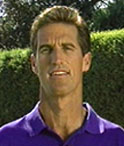Court Movement:
The "Float"
By Bob Hansen
Now that we've looked at the basic movement patterns, (Click Here) let's see how we can speed up our movement in certain situations using a move that I call "The Float."
Let's see how The Float applies in two critical areas that put pressure on our movements skills: approaching the net and the return of serve.
Learning the Float can help you become a great all court player. |
Attacking the Net
Being a great all court player means learning how to move forward when you have an opportunity to attack the net.
As you move forward, the key is to stay balanced so that you can change directions and make a good Initial Move to the first volley.
The Float Move speeds up your ability to break to the ball. Although similar to the split step, the Float move allows explosive movement in any direction, similar to "unweighting" in skiing.
The Float sequence: unweight, touch and push off with the Inside Foot. Step to the ball with the Outside Foot
|
Unweighting
Watch how I unweight and touch and go to the ball. You can see the sequence in the animation freeze frames.
First, I unweight, pushing off so that both feet are momentarily in the air. Next I touch down with the Inside Foot. Now the Inside Foot pushes of in the direction of the movement. Finally I take a step to the ball with the Outside Foot.
As with the patterns of movement in the other articles, by Outside Foot I mean the foot closest to the ball. This is the left foot on the forehand if you are right handed. The Inside Foot is the right foot, further away.
The Float on the backhand approach and volley. |
The Float on the Backhand Volley
The float move works in the same way for backhand volley, except the pattern is reversed.
Now the Outside Foot closest to the ball is the left foot for a righthander, and the right foot is the Inside Foot.
First the player unweights. Then he touches and pushes off with the Inside Foot and steps to the ball with the Outside Foot.




